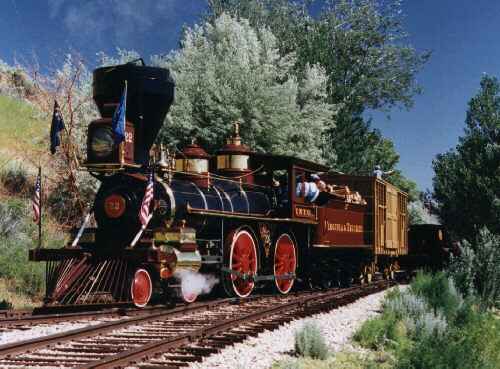Grab a cuppa, sit back and enjoy this video of a truly great little engine!
V&T No. 22 "INYO"

Pictured at Carson City during the Fourth of July celebration.
To see No. 22 in action July 4th, 2004
weekend, click here
Other than the famous RENO steam locomotive, the second most popular iron
horse on the V&T is the INYO. Out shopped by Burnham, Parry, Williams & Company,
Baldwin Locomotive Works in February of 1875, the 4-4-0 arrived in Reno on March
22, along with the J. W. BOWKER, to begin a long career starting in April. The
wood burner cost $9,065 and when filled to capacity with approximately 2,000
gallons of water and three cords of wood, weighed over 58 tons, INYO, the name
applied, is Indian meaning "dwelling place of a great spirit." INYO is also
affixed to a lengthy mountain range and a large county in eastern California.
No. 22, nicknamed the BRASS BETSY, gained the admiration of many of the road's
veterans and rightly so as it came furnished with an enormous amount of highly
polished brass work including the bell and bell stand, steam dome and sand box
casing, boiler jacket bands, cylinder jackets, and running board edging.
By 1879, the brass bedecked engine was employed in the V&T's regularly scheduled mixed passenger and freight service. At other times it substituted for the RENO and GENOA engines when they were in the shop. Beginning in the 1890's, No. 22 handled the road's crack Virginia City express train and saw extensive use during the Tonopah mining boom soon after 1900. In 1910, the INYO was next to the last of the V&T iron horses to be converted to burn oil. From 1926 on, the engine was considered to be retired, although she did replace the RENO occasionally.
The BRASS BETSY became the first of many V&T cars and locomotives acquired by Paramount Pictures. In 1937 No. 22 starred in HIGH, WIDE AND HANDSOME, followed by roles in UNION Pacific, RED RIVER and Disney's THE GREAT LOCOMOTIVE CHASE. She last operated in 1965 for the TV series WILD, WILD WEST. Four years later the INYO participated in the Gold Spike Centennial at Promontory, Utah. Starting in 1970, the engine appeared as a replica of the Central Pacific's JUPITER at the Gold Spike National Historical Site. The State of Nevada purchased the 4-4-0 in 1974 and when it was no longer need for display the ex-V&T engine returned home to Carson City. After more than a year of restoration work, the INYO made her debut on May 29, 1983. Since then the wood-burning BRASS BETSY has operated on numerous occasions and participated at the grand opening of the Palace Station Casino in Las Vegas during April of 1984. It was also one of the stars at the 1996 4th of July Transportation Fair.
| Builder: | Burnham, Parry, Williams & Company, Baldwin Locomotive Works, Philadelphia, Pennsylvania |
| Date: | February 1875 |
| Gauge: | 4 feet 8-1/2 inches. 3/4 inch play |
| Type: | 4-4-0 American |
| Class: | 8-26 C 78 |
| Builder Number: | 3693 |
| Road: | Virginia & Truckee Railroad Company |
| Number: | 22 |
| Name: | "Inyo" |
| Service: | Passenger |
| Fuel: | Wood |
| Cost New: | $9,065.00 |
| Tractive Power: | 11,705 lbs. |
| Boiler Pressure: | 130 lbs |
She is beautiful. Glad I don't have to polish all that brass. Quite a history.
ReplyDeleteAlthough she is standard gauge, did you notice the dual gauge track?
Terry
Fla.
You just knew I had to see why they had dual gauge track. The museum also has a narrow gauge (3') locomotive, the Glenbrook, a 2-6-0 Mogul undergoing extensive restoration. There is a Wikipedia entry on it.
ReplyDeleteTerry
Fla.
When they finish it - I'll post it!
DeleteShe is just picture perfect! Love all the the brass - there is so much of it. Did notice the tracks at the end - had never seen that before.
ReplyDeleteWhat about the tracks? If it was the three rails, that is what I was talking about when I said dual gauge. I can expand on it if you are interested. (and if that was it)
ReplyDeleteTerry
Fla.
You can see them at 7:21. I thought they were for different gauges to run at different times.
DeleteIs that common? New to me.
Yes, different gauges at different times. In the picture you see 3' narrow and 4' 8" standard gauges. It isn't common now (to my knowledge) but was years ago. I first saw it reading about the East Tennessee and Western North Carlonia railroad. (ET&WNC aka The Tweetsie and sometimes the Eat Taters & Wear No Clothes).
ReplyDeleteIf you are interested I will do a bit more research and send it.
Terry
Fla.
Yes, when you have time! You know, I heard that 'tater' expression when I was a very little kid - don't remember where though.... or why ... some stuff just stays in the broom closet of my brain....... (sigh)
Delete